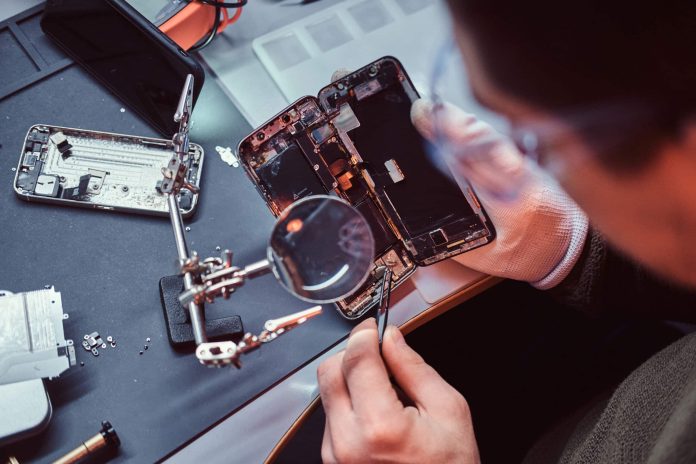One of the biggest challenges in the service-based sector is order fulfillment. The reason is that you have a lot of dependencies. For instance, you might not have the best man at work the day a customer asks for same-day cell phone repair. But the worst-case scenario is when you run out of spare parts and have to move the order to the next day.
What you can do is partner with some big names like MobileSentrix cell phone parts suppliers and automate your parts sourcing process. Read on to find out how you can achieve this for your cell phone repair store.
Accessories and Parts in Cell Phone Repair
Finding top-notch parts is essential to a repair shop’s success. After a repair, customers expect their phones to function like new again, and a functional component can make all the difference. To satisfy consumer demands, standard parts like screens, batteries, cameras, and charging connections must be easily accessible. Cases, screen protectors, and chargers are examples of accessories that are important for increasing customer pleasure and making extra money.
Finding dependable parts that satisfy quality standards is difficult, though. The sheer number of phone types available makes sourcing even more difficult. There is also a constant requirement for a varied inventory because repair shops must stay up to date with new models while still being able to service older ones due to the quick changes in technology.
Where Do Repair Shops Find Replacement Parts?
Apple only allows approved service providers to sell parts, which makes it challenging for independent stores to obtain authentic parts. Many repair shops are forced by this restriction to look for other suppliers, particularly if they wish to provide services for well-known brands with stringent distribution regulations.
Approved Wholesalers and Distributors
Authorized distributors are allowed to offer authentic parts to independent repair shops and collaborate closely with OEMs. These wholesalers usually guarantee that every part satisfies the original requirements, assisting retailers in upholding their standards for quality.
Conversely, wholesalers provide repair shops with a more cost-effective choice, especially for high-quality but non-OEM parts. Although they are made by businesses unrelated to OEMs, aftermarket parts adhere to the same requirements. Although the quality of these parts might vary greatly, they are frequently less expensive.
Assuring dependability is the primary difficulty with third-party components. The reputation of the store could be harmed by a subpar part that causes returns or even damage to a customer’s gadget. Successful repair shops typically thoroughly screen these manufacturers and build reliable connections with particular providers in order to reduce risk.
Also, check out the best diagnostic software that you can use to test cell phones at your repair store.
The Difficulties of Finding Replacement Parts
It is rarely easy to get high-quality parts and accessories. As they strive to offer consumers dependable services, cell phone repair shops frequently encounter formidable obstacles.
1. Problems with Quality Control
Assuring consistent quality is the most difficult component of procuring spare parts. Because there are so many options available, repair firms may find themselves using subpar parts. Low-quality components may cause the phone to function poorly or possibly sustain further harm.
Successful repair shops frequently put strict quality control procedures in place to overcome this. This can entail putting components through testing before usage or working exclusively with reliable vendors who uphold strict standards. These procedures guarantee that shops can provide excellent repairs that satisfy patrons.
2. Fake Components
In the field of cell phone repair, counterfeit parts are a common problem. Some dishonest vendors provide parts that seem authentic but don’t fulfill the required performance requirements. Fake parts have the ability to damage gadgets and damage a store’s reputation.
By procuring from approved vendors and confirming the origin of each part, astute repair shops reduce this danger. Additionally, they train their employees to spot fake parts by looking for variations in branding or packaging.
3. Variations in Prices
Prices might vary greatly when there is a large demand for particular phone models or parts. Because of this, stores find it difficult to keep steady profit margins. For example, a popular phone model with a screen that cracks easily could cause screen prices to rise as demand increases.
Successful repair businesses frequently collaborate with several suppliers to handle these swings, enabling them to compare costs and get the best offers. Diversifying their sources allows them to control expenses without sacrificing quality.
4. Management of Inventory
Efficient inventory management is necessary to maintain the correct parts in stock. Stores must strike a compromise between preventing overstock, which holds up cash flow, and having enough parts for common repairs. Inventory management can easily get complicated with so many models and components to monitor.
Many repair shops utilize inventory management software to estimate demand, keep track of stock levels, and place parts orders as needed in order to address this issue. This reduces the possibility of stock shortages while enabling them to remain responsive to consumer needs.
In Conclusion
Finding replacement parts and accessories is a challenging but essential aspect of managing a profitable cell phone repair company. Despite the many obstacles, successful repair shops use a mix of best practices to guarantee a consistent supply of high-quality parts. Repair shops can get over sourcing challenges by establishing trusting relationships with suppliers, putting quality control in place, diversifying their sources, and keeping abreast of market developments. In the end, these initiatives allow them to offer dependable repairs that attract repeat business.
